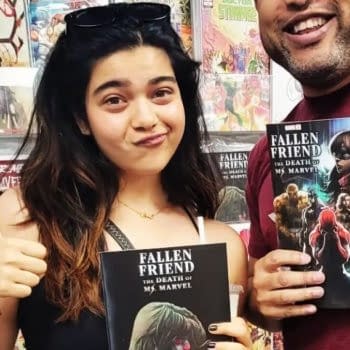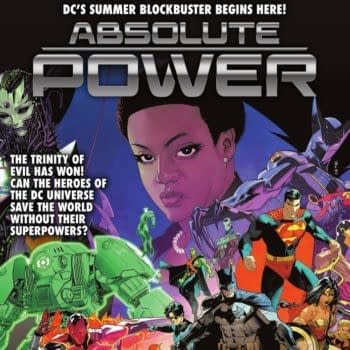Posted in: Comics, Recent Updates | Tagged: Comics, Convergence: Batman and the Outsiders, Convergence: Hawkman, Convergence: The Flash, Convergence: The New Teen Titans, dc comics, Elsa Charretier, Empire: Uprising #1, entertainment, idw, Pierrick Colinet, The Infinite Loop
Thor's Comic Review Column – Convergence Week 3 Titles, The Infinite Loop #1, Empire: Uprising #1,
This Week's Reviews:
Convergence #3
Convergence: Batman and the Outsiders
Convergence: The New Teen Titans #1
Convergence: The Flash #1
Convergence: Hawkman #1
The Infinite Loop #1
Empire: Uprising #1
Convergence Week 3
By Graig Kent
It is getting close to that time where I'm regretting my self-imposed weekly Convergence coverage because this event mini-series is becoming a ruddy chore.

At this stage, the six heroes from Earth 2 haven't shown any such measure of trying to stop Telos' mad scheme beyond just punching him a lot. He's a living planet folks, that ain't going to cut it. But then again, both the planet and the bipedal manifestation of Telos seem thoroughly ill-defined, with no real parameters of what he/it can or cannot do. Telos is able to pour drone machines up out of the soil, he's able to raise domes and raze cities with a thought, and kill the most powerful individuals (like a city of Kryptonians), but at the same time he seems to need a bank of monitors to observe what's happening on his planet/itself so Telos does not seem to have omnipresence. It seems odd. (Then again if an ant crawled on my skin, I would notice, but a hundred million ants were on me I probably wouldn't be aware of what a single or small group of ants was up to). And just what is Telos getting out of this? Is the living planet just on a power-trip?
This issue features a plentitude of deaths. A Batman, a Joker, a dozen or so bat-villains, the whole bottle city of Kandor… but it all rings so terribly hollow, a "kill-them-because-we-can" situation. If any of these cities or characters were from active realities, their lives, and deaths, wouldn't be so easily tossed off, or so meaningless. As well I still have issue with the book centering itself around the Earth 2 heroes and their journey through the convergence. To reiterate my point from last week, it's seems small potatoes for an event book. The Monitor in Crisis on Infinite Earths brought together a bunch of characters from Earths that had been destroyed or were in jeopardy. Through those focal characters it gave the book a grander sense of scale and many points of view to play with. This just seems oversimplified.
The big point of intrigue from last issue, the appearance on the final page of Deimos from Warlord, didn't really pay off this issue either. The Earth 2 gang does make it to Skartaris, but not until the last page of their adventure this week. We catch a new piece of intrigue (nonsensical intrigue, no less) with Deimos' right-hand aide, Shakira, operating some sort of heavy machinery which she uses to place Monarch (from Armageddon 2001) and Justice Society villain Per Degaton into the Vanishing Point with a bunch of other "Time Masters" (Goldstar, Booster Gold's sister, is the only other figure I could recognize). While it seems utterly incongruous to have Shakira in her fur bikini operating high-tech equipment, it's even more baffling how exactly Deimos was able to capture all these "Time Masters" from other cities given Telos' (arguably unevenly capable) security drones that patrol the perimeter (he really needs Rovers like from The Prisoner).
Penciler Stephen Segovia and inker Jason Paz step in on art chores this issue. The style is immediately appealing as they capture the central figures boldly, but their background work, particularly the background characters, have little attention paid to them. The citizens of Kandor look as generic and style-less as possible, and, as mentioned, the "Time Masters" Shakira is trapping in the Vanishing Point are rendered so vaguely, it's almost impossible to discern who they are. The fact is where Segovia is called upon to use minimal imagination (plentiful desert scenes abound yet again), he fares quite well, but when some creative scenery or world building is involved he fails to deliver.
—
With big month-eating events like this or "Future's End month" or "Forever Evil month" or even just your basic event crossovers (like DC One Million) I have a strong desire to go all-in on them, and just as strong a desire to bail out entirely. The long-time DC fan in me usually wins out, but when a full compliment of titles will run you $44 a week (at least), it's a costly proposition for questionable returns on what's really more of an academic reading exercise than an enjoyable one. With Convergence I was hoping to get away with reading maybe a half dozen books… I wasn't even really planning to buy the main series, but curiosity (and some suave marketing) obviously got the better of me. But now that I've bought in just a little, my urge is to go for broke.
It's the academic impulse taking over, the desire to find out which tie-ins work the best? Which are the worst? Which feels most like the era its from? Which abandons the event conceit in favor of its own story? And on. and on. So when it came to this week, where I had to pick three or four tie-ins using characters from pre-Crisis on Infinite Earths, I didn't know which to choose outright. I'm mostly a post-Crisis kid, so books from before that time are a bit more of a vague, curious memory of random issues. The academic in me pushed for those series written by writers of the era (like Marv Wolfman on The New Teen Titans and Adventures of Superman, or Len Wein on Swamp Thing) while the fanboy in me was looking for the most interesting solicit copy (Batman and the Outsiders versus Omac? I'm in). In the end I split the difference.

The formula of the tie-in books is becoming readily apparent. Issue #1 of most of these titles is about catching up with the titular heroes in their domed city, still trying to figure out a way of life both without powers and cut off from the rest of humanity. The formula is even more oppressive here as it separates the various Outsiders and shows us what each of their lives are like a year later under the dome. If this is the only Convergence tie-in you pick up, it's absolutely fine. If it's your 6th or 10th or 20th, then it's going to feel tedious and redundant.
Mark Andreyko offers little nuggets amid the tedium, like the fact that Metamorpho is able to live a normal life with Sapphire Stagg without his powers ("Ironic, isn't it," Batmay says. "Rex's dream only costs the nightmares of a few million others"). Yet, he also misses big opportunities to explore the conceit of Convergence, such as Batman having no more knowledge about their situation under the dome on day 364 than on day 1. Andreyko could have detailed perhaps some of Batman's more scientific and exploratory measures, or really gotten into the detective elements, like trying to find out where the city is getting its fresh water from.
Some distinctive, eye catching art from Carlos D'Anda helps sell the repetitious nature of the book a little more than some of the other tie-ins, but the story itself doesn't really have a reason for being.
—

In Wolfman's hands, this book feels like a part of something huge, something the main Convergence series fails to capture. By inundating the reader with all the team's twists of personal conflict, of inner turmoil and other adversity (like Cyborg's failing power system), he's able to throw in the outer conflict of the Tangent universe's Doom Patrol, and then layer in the greater mutual threat they face. Wolfman is a master juggler and Convergence: The New Teen Titans is the best fitting tie-in of the event so far. It captures both the throwback feel that was the initial draw for this event, while also doing something interesting with the conceit he's been presented with. (I skipped Wolfman's Convergence: Adventures of Superman this week, but I just may have to go back and get it). What was missing from the Outsiders tie-in (and so many others) is what I found here: characters thinking about their situation (both on the Titans but even more so on the Tangent side) and looking for answers that may be outside of what's on the surface. Digging deep, peeling back the layers.
Of course, Wolfman is aided in no small way by having Nicola Scott as his artist on the book. While Scott isn't quite the detail-maven that George Perez is (because really only Geoff Darrow trumps him in that category), she does deliver detail-packed pages that emulated Perez nicely (Marc Deering's inks also mimic Perez's line style, adding more to the throwback feel). Scott is one of the industry's master superhero artists. She gets what makes spandex and superpowers feel oh so right, without looking silly or awkward. And for all the attention to detail in the background of the page, she doesn't ever falter in her storytelling. She takes Wolfman's dense script and displays it visually like a master.
—

It didn't start off very promising, as Barry narrates how he accidentally got caught in Gotham City when the dome went up, how he lost his powers, and how achingly difficult it is to be normal again, but even more, separated from his true love Iris. Barry's been set up with a life in Gotham, working forensics for the GCPD (no doubt some maneuvering on Bruce Wayne's part), but as he tells Bruce on a coffee date, he's starting to feel defeated, lost. (I was initially worried about the narration the book started off with, as the narrative device's connection with the Flash really originated with Wally West, but it turns out he's just relating his feelings to Bruce over coffee). Barry's getting by, but just barely.
Dan Abnett does a phenomenal job of establishing the routine of Barry's daily life, perfectly illustrated with precise four or five panel stacks from Federico Dallocchio that detail with sublime nuance just how heavily the unknown weighs on Barry as he goes about his day. The weight of the mundane in Abnett's script totally sets the story ups for Barry's to do something spectacular when the dome lifts and his powers return. Even that conversation with Bruce seems loaded with meaning that Barry will do something different.
Yet, the dome lifts, that same speech from Telos we've seen issue after issue, week after week is given (still nobody picks up on the "your worlds are dead" comment that should just crush Barry here, or Donna in The New Teen Titans, or Wally West in Speed Force, people who are desperately longing for their absent partners), and the powers return. Abnett and Dallocchio brilliantly capture the glory of Barry's returning powers (it's really storytelling tour-de-force on Dallocchio's part), unfortunately all it leads to is the same "we're not on Earth" shock most of the other books have had and the surprise final page face off against their opponent (in this case, Tanget universe's Superman). Such a disappointment.
—

Convergence: Hawkman brings Timothy Truman back to the characters he's probably best known for (although his time on Hawkman saw him reboot the character after the Shadow War story), joined by inker Enrique Alcatena. Even after all this time (about 25 years) and working on a different iteration of the character, it still feels like a natural fit. Though Truman's figures are at times stiff or his action is awkward, the overall gritty tone, led by the heavy weight of his lines and feathering accents, feels perfectly in key for a weird animal-themed superhero from outer space embroiled in interplanetary espionage.
Jeff Parker has a harder time fitting naturally with the character. His script has difficulty resolving the weird-animal-themed-superhero-from-outer-space-embroiled-in -interplanetary-espionage with the requirements of being a Convergence tie-in. Many of these tie-ins have difficulty rationalizing why the characters are in a city that's not their home city while still having a secret identity that resembles their normal. Parker essentially has Carter and Shiera Hall seconded to the Gotham City Museum, but it feels like a forced "private life" subplot not really relevant to the story at large. Parker manages to capture the shadow war facet of that era's Hawkman very well, and he gets more mileage integrating Convergence into his story, but not so much vice versa. This is actually more of the kind of story I would like out of the Convergence tie-ins, one that by and large operates on its own terms, it's just unfortunate that this one's kind of a dull read.
—
In spite of my dwindling enthusiasm, next week is actually the week I'm most excited about. It's pre-Crisis characters from other Earths (Earth 2 JSA and their Infinity Inc. kids, Earth 3 Crime Syndicate, Uncle Sam and the Freedom Fighters, the Marvel Family, Blue Beetle and the Charlton Earth, plus a Booster Gold book). These are all characters that pre-date my comics reading, and characters who I've been wanting to read in in their environment but written with contemporary style. I'm so enthused I may just get all the books next week. But I probably shouldn't since I'm sure I'm going to be horribly disappointed.
Graig Kent's first novel, Quarter City,can be read for free on the Wattpad app. Set in alternate universe, the story is framed around society's reactions to beings with super powers, focusing on the extreme actions of the city's most powerful Enhanced in particular. You might like it. Graig sometimes tweets stuff @thee_geekent and he does various other things in other places.
The Infinite Loop (IDW Publishing)
By Bart Bishop

The first issue starts in medias res, following Teddy as she thunders through the desert in a muscle car that conveniently has a hologram projector on its dashboard. She's an old hand at her job, in fact she's "timeless", and that job is dealing with time anomalies when and if they arise. She's at odds with time paradox forgers, terrorists that are as of yet unseen but definitely felt as their initiative has increased recently. Teddy finds herself encountering simple anomalies like lamps and record players in the desert, and a conspicuous Roman throne, only to run right into Tyrannosaurus Rex. Previously anomalies were only inanimate objects, but more and more they've been living things. Threat handled, Teddy and her handler Ulysses get together to discuss life, the universe and everything, end up having a time race during a masterful sequence, and after an awkward near-kiss part ways. Sometime later while on mission Teddy runs into a mysterious woman that the cover and artist's included-essay promise will be kind of a big deal.
I'm not familiar with Colinet, but so far I'm liking what I'm reading. There's a definite sense of awareness of time travel's place in pop culture, as there are references to everything from Star Trek to Looper. But no good story relies on references alone, and this differentiates itself immediately. Teddy is a strong character, gruff and mostly surface level at this point but along with likability competent characters that are good at their job are compelling, and Teddy is very good at what she does. It's also nice that Ulysses (Uly to Teddy) is the meek one, essentially Teddy's secretary, while Teddy is the heavy. At the same time it's nice to see the ease and familiarity of their interaction, and especially knowing in retrospect that it won't lead to romance it's cool that they're just friends. There's also a perfect balance of tone, with the action being a rollicking good time but all of the spectacle grounded by Teddy's pessimism and worldly cynicism.
The real standout is the virtuoso art by Charretier. She definitely has a style reminiscent of Darwyn Cooke and Cameron Stewart with sharp art deco lines and ad world sensibilities. She knows how to draw a woman with curves, too, but not in a sexualized manner that feels exploitive, even with the mysterious stranger at the end. Off-kilter angles and long stretches of silence build up to crescendos, and one of my favorite things exemplifying the uniqueness of the comic book medium is the utilization of sound effects and captions, in the grand ol' Will Eisner tradition. Here there's cute moments like Teddy inhaling and exhaling, but the accompanying floating explanations for the anomalies and especially the choose-your-own-adventure diagram that pops up when Teddy faces the dinosaur (and makes a brief and thematically appropriate appearance again at the end) really shout to the world that this is an artist to watch out for, and this is a comic to follow.
So I'm definitely intrigued. Too often worldbuilding is a deterrence to character work, but here the two run hand in hand. This is a story in which everything but the kitchen sink has been thrown out, but I trust the creators to handle it with grace and tact.
Editor and teacher by day, comic book enthusiast by night, Bart has a background in journalism and is not afraid to use it. His first loves were movies and comic books, and although he grew up a Marvel Zombie he's been known to read another company or two. Married with a newborn baby girl, he sure hopes this whole writing thing makes him independently wealthy someday. Bart can be reached at bishop@mcwoodpub.com.
Empire: Uprising #1 (IDW, $3.99)
By Jeb D.

That comic is now being issued in print form, and issue #1 is a sobering way to resume the story, as we see the devastation of life under Golgoth's rule, and the determination of its resistance. Golgoth may appear as cartoonish as Kang or Brainiac, but his murderous enforcement of a silent tribute to his late daughter is a reminder that characters like this are often more grounded in the real world than their goody two-shoes opponents: few of us encounter many billionaire vigilantes or irradiated teenagers, but a good chunk of the world's populace lives under exactly the sort of brutal dictatorship that Golgoth imposes, giving the "freedom fighters" who oppose him more resonance than their on-page characterization actually achieves. Golgoth's daughter was probably the best-developed character in the first series, and with her gone, it remains to be seen if anyone else here will enlist our sympathy as completely. But there's action aplenty, beautifully rendered by Kitson, and the promise of an intriguing mystery. There's something to be said for a comic that keeps you coming back simply to find out what's going to happen, even if you'd prefer to be more engaged with the characters to whom it's happening.
Jeb D. goes in to tech next week, and is not ready for it.















